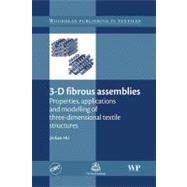
| The Textile Institute and Woodhead Publishing | p. ii |
| Woodhead Publishing in Textiles | p. ix |
| Preface | p. xv |
| Acknowledgements | p. xviii |
| Introduction to three-dimensional fibrous assemblies | p. 1 |
| Introduction: concepts of three-dimensional fibrous assemblies | p. 1 |
| Two-dimensional structures (two-dimensional fabrics) | p. 2 |
| Limitations of two-dimensional textile structures | p. 7 |
| Three-dimensional structures (three-dimensional fabrics) | p. 8 |
| Conclusions | p. 30 |
| References | p. 31 |
| Applications of three-dimensional textiles | p. 33 |
| Introduction | p. 33 |
| Application of three-dimensional fabrics to composites | p. 34 |
| Application of three-dimensional fabrics to medical textiles | p. 50 |
| Application of three-dimensional fabrics to sports | p. 53 |
| Application of three-dimensional fabrics to geotextiles | p. 56 |
| Application of three-dimensional fabrics to automotives | p. 60 |
| Application of three-dimensional fabrics to protective clothing and the aerospace industry | p. 62 |
| References | p. 66 |
| Multiaxial warp-knitted fabrics | p. 70 |
| Introduction to multiaxial warp-knitted fabrics | p. 70 |
| Advantages of multiaxial warp-knitted fabrics | p. 72 |
| Manufacture of multiaxial warp-knitted fabrics | p. 73 |
| General structure and behaviour of multiaxial warp-knitted fabrics | p. 81 |
| Applications of multiaxial warp-knitted fabrics | p. 97 |
| Summary | p. 100 |
| References | p. 101 |
| Multilayer woven fabrics | p. 104 |
| Introduction to multilayer woven fabrics | p. 104 |
| Advantages of multilayer woven fabrics | p. 105 |
| Manufacture of multilayer woven fabrics | p. 106 |
| General structure and behaviour of multilayer woven fabrics | p. 113 |
| Applications of multilayer woven fabrics | p. 127 |
| Summary | p. 129 |
| References | p. 130 |
| Tensile properties of multiaxial warp-knitted fabrics | p. 131 |
| Introduction | p. 131 |
| Tensile behaviour of multiaxial warp-knitted fabrics | p. 132 |
| Modelling tensile properties of multiaxial warp-knitted fabrics | p. 139 |
| Experimental methods and validation | p. 147 |
| Conclusions | p. 149 |
| References | p. 151 |
| Bending properties of multiaxial warp-knitted fabrics | p. 153 |
| Introduction | p. 153 |
| Bending properties of multiaxial warp-knitted fabrics | p. 155 |
| Bending hysteresis curves of multiaxial warp-knitted fabrics | p. 159 |
| Buckling of the bent-inserting yarns | p. 162 |
| Effect of bending sequence on bending hysteresis curves | p. 162 |
| Cyclic bending | p. 163 |
| Modelling bending properties of multiaxial warp-knitted fabrics | p. 164 |
| Model validation | p. 169 |
| Conclusions | p. 171 |
| References | p. 173 |
| Formability of multiaxial warp-knitted fabrics | p. 174 |
| Introduction | p. 174 |
| Textile composite deformation mechanisms | p. 176 |
| Structure of multiaxial warp-knitted fabrics | p. 179 |
| Deformation characteristics of woven fabrics during the forming process | p. 180 |
| Deformation characteristics of multiaxial warp-knitted fabrics during the forming process | p. 180 |
| Deformation behaviour of two-bias multiaxial warp-knitted fabrics | p. 182 |
| Modelling the formability of two-bias multiaxial warp-knitted fabrics | p. 188 |
| Summary | p. 190 |
| References | p. 192 |
| Permeability of multilayer woven fabrics | p. 194 |
| Introduction | p. 194 |
| Fabric compressibility | p. 200 |
| Permeability testing | p. 201 |
| Monofilament permeability model | p. 207 |
| Fractal permeability model | p. 214 |
| Conclusions | p. 216 |
| References | p. 217 |
| Using multilayer woven fabrics in resin transfer moulding | p. 221 |
| Introduction | p. 221 |
| Flow resistance of multilayer woven fabrics | p. 223 |
| Flow modelling of multilayer woven fabrics | p. 225 |
| Modelling flow and void formation | p. 228 |
| Modelling the effect of stitch size, distribution and position | p. 237 |
| Conclusions | p. 251 |
| References | p. 252 |
| Index | p. 254 |
| Table of Contents provided by Ingram. All Rights Reserved. |
The New copy of this book will include any supplemental materials advertised. Please check the title of the book to determine if it should include any access cards, study guides, lab manuals, CDs, etc.
The Used, Rental and eBook copies of this book are not guaranteed to include any supplemental materials. Typically, only the book itself is included. This is true even if the title states it includes any access cards, study guides, lab manuals, CDs, etc.